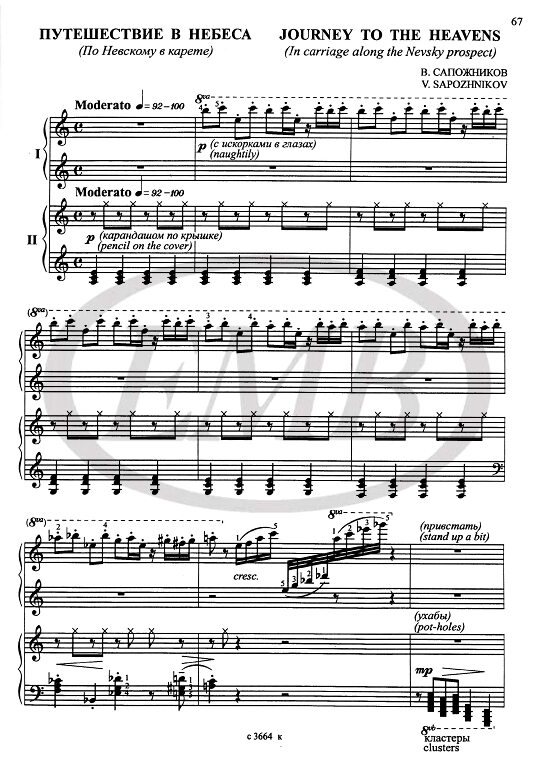
Happy Present Meet
Brother and Sister. Ensembles for Piano in 4 Hands. Educational repertoire of Children Music School. Vol.1
Krishtop Ljubov Pavlovna
Language Russian, English
Contents:
R. Glier. Hymn to the Great City. From the ballet “Bronze Horseman”
A. Glazunov. Grand Pas Espagnol. From the ballet “Raymonda”
S. Prokofiev. Gavotte. From the “Classical Symphony”
S. Prokofiev. Waltz “Cinderella Setting off to the Ball”. From the ballet “Cinderella”
S. Prokofiev. Spring Fairy. From the ballet “Cinderella”
S. Prokofiev. Bourree. From the ballet “Cinderella”
D. Shostakovich. Spring Waltz. From the ballet suite
S. Banevich. Waltz “Petersburg”. From the ballet of the same name
S. Banevich. Snow-White And Scarlet Flower
O. Petrova, A. Petrov. Waltz. From the serial “Petersburgian Mysteries”
V. Sapozhnikov. Journey to the Heavens. (In carriage along the Nevsky prospect)
The middle of the 18th century is truly considered to have been the birth-time of the piano ensemble genre. The four-hands compositions were enough easy to play even for the music lovers. Such genres occurred to be useful for pedagogical aims. The end of the 18th century and the beginning of the 19th century brought the real flourishment to piano ensemble. That time there appeared the orchestra music transcriptions, beside the original four hands compositions. Mutual music-making served both for communicative and educational purposes. People could study symphonies, symphonic poems, operas and other large-scaled compositions. Beside many compositions intended for home music-making and pedagogical work there were created many special pieces for concert stage. Of course, they required skill and wrought interpretation. Numerous compositions for four hands came into being exactly at the end of the 18th century. Those were sonatas by J. Haydn, W. A. Mozart, H. Wolf, J. Hässler, F. Kulau, M. Clementi, A. Diabelli. Later the immense tribute to piaano ensemble was brought by the composers-romanticists F. Schubert, C. M. Weber, J. Hummel, J. Brahms, F. Mendelssohn, R. Schumann, G. Bizet, C. Debussy, M. Ravel, M. Glinka, A. Dargomyzhsky, A. Borodin, A. Rubinstein, S. Rachmaninov etc.
During the last decade of the 20th century the genre of piano ensemble got its renaissance due to numerous chamber music festivals and contests. One of such competitions is called "Brother and Sister", being held within the framework of the Children Musical Festival "Children's Land" in Petersburg. Lots of duets came into being as if from the cornucopia. The Petersburgian composers managed to inundate both pedagogical and concert sphere with piano duets.
18세기 중반은 피아노 앙상블 장르의 탄생지로 여겨집니다. 네 손으로 연주하는 곡들은 음악 애호가들에게도 충분히 연주하기 쉬웠습니다. 이러한 장르는 교육적 목적으로도 유용하게 활용되었습니다. 18세기 말과 19세기 초는 피아노 앙상블이 진정한 전성기를 맞이하는 시기였습니다. 당시 네 손으로 작곡된 원곡 외에도 오케스트라 편곡이 등장했습니다. 함께 음악을 연주하는 것은 소통과 교육적 목적 모두에 기여했습니다. 사람들은 교향곡, 교향시, 오페라, 그리고 기타 대규모 작품을 공부할 수 있었습니다. 가정 음악 제작과 교육적 목적을 위한 많은 작품 외에도 콘서트 무대를 위한 특별한 작품들이 많이 탄생했습니다. 물론 이러한 작품들은 뛰어난 기술과 정교한 해석을 요구했습니다. 네 손으로 연주하는 수많은 작품이 바로 18세기 말에 탄생했습니다. 이 곡들은 J. 하이든, W. A. 모차르트, H. 볼프, J. 헤슬러, F. 쿨라우, M. 클레멘티, A. 디아벨리의 소나타였습니다. 이후 F. 슈베르트, C. M. 베버, J. 훔멜, J. 브람스, F. 멘델스존, R. 슈만, G. 비제, C. 드뷔시, M. 라벨, M. 글린카, A. 다르고미츠키, A. 보로딘, A. 루빈스타인, S. 라흐마니노프 등의 작곡가 겸 낭만주의자들이 피아노 앙상블에 지대한 찬사를 보냈습니다.
20세기 마지막 10년 동안 피아노 앙상블 장르는 수많은 실내악 축제와 콩쿠르를 통해 르네상스를 맞이했습니다. 그중 하나인 "형제 자매" 콩쿠르는 상트페테르부르크에서 열린 어린이 음악 축제 "어린이들의 나라"의 일환으로 개최되었습니다. 마치 풍요의 뿔에서 나온 듯 수많은 듀엣이 탄생했습니다. 상트페테르부르크 작곡가들은 교육계와 연주계 모두에 피아노 듀엣을 쏟아부었습니다.
편곡자 Pavlovna, Krishtop Ljubov
작곡가 Banevich, Sergei
Glazunov, Alexander (1865-1936)
Gliere, Reinhold (1875-1956)
Prokofiev, Sergei(1891-1953)
Sapozhnikov, V
Shostakovich, Dmitri (1906-1975)
Various
